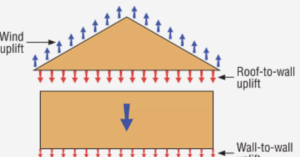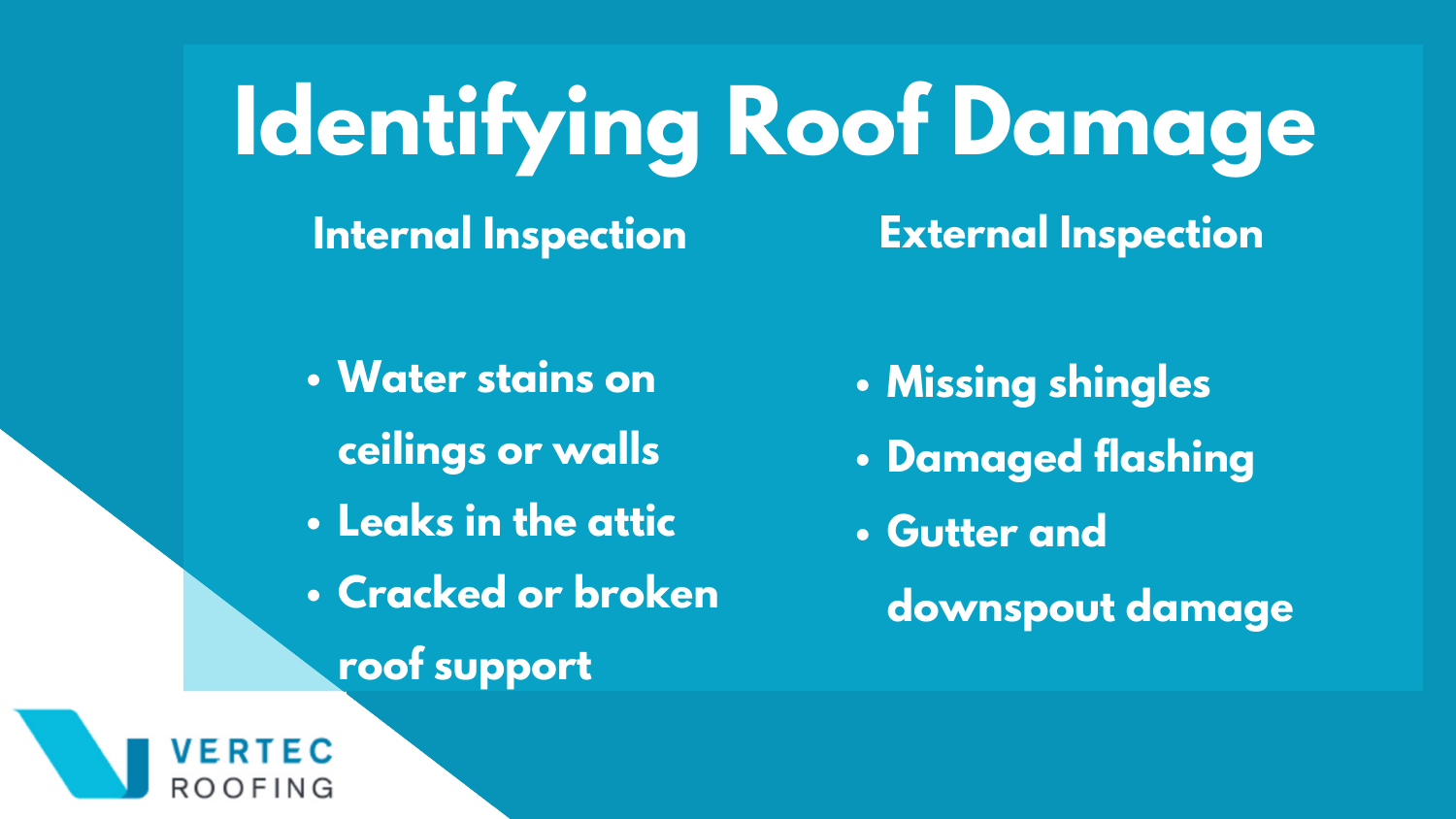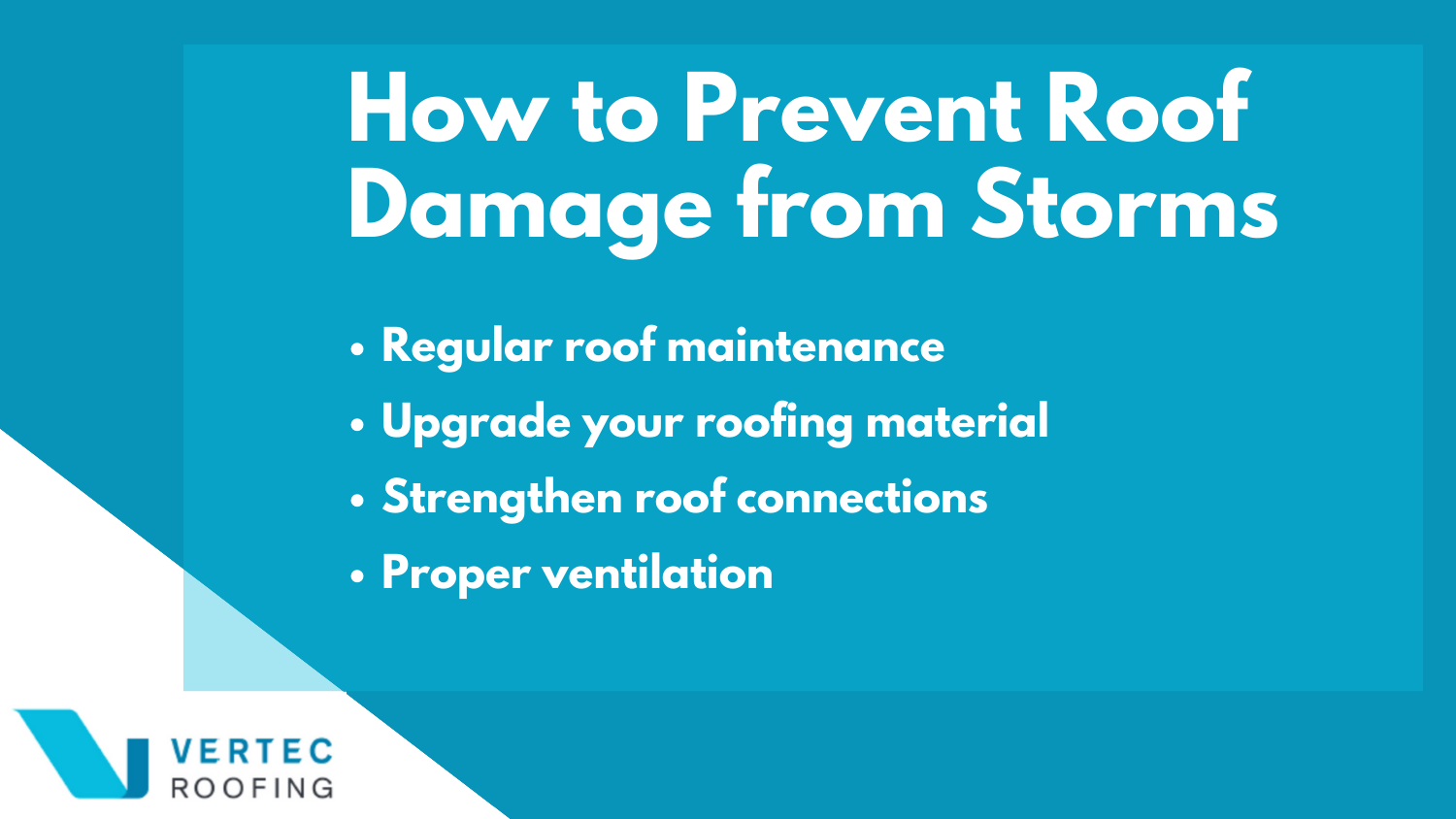

High winds can be one of the most harmful forms of weather for your roof, wreaking havoc on your roofing materials, gutters, and flashing. It’s important to identify damage early on to avoid costly roof repairs and protect your roof from destructive storms and high winds. In this article, roof experts from Vertec Roofing will discuss how to identify and prevent roof damage from high winds.
Roofs are built to last, but high winds and storms can damage your roofing materials depending on their age, the quality of materials, the condition of the roof’s structure, and the strength of the winds. If you’re concerned about your roof’s ability to withstand a strong storm, it’s essential to assess any vulnerabilities and deal with them accordingly.

After a high wind event or storm, it’s normal to be worried about your roof. Check your roof thoroughly for any signs of damage, both inside and outside.
During your external inspection, you should keep a lookout for the following signs of roof damage:
Missing or damaged shingles — High winds can lift, break, or tear away shingles. This can expose your roof and ceiling to water damage. To avoid extensive damage, look for areas with missing or damaged shingles and replace them immediately.
Damaged flashing — Flashing is used to seal joints on a roof and is typically made of plastic or metal. Keep an eye out for bent, loose, or missing flashing. Repair or replace damaged flashing immediately to keep your roof properly sealed.
Gutter and downspout damage — Gutters and downspouts can be dislodged or damaged by high winds or storms. When checking for damage, ensure your gutters are securely attached and free from dirt and debris.
While you may think the damage occurs outside your house, don’t forget to check the interior for these signs of roof damage:
Water stains on ceilings or walls — If you spot any stains or damp areas, you may have a leak in your roof caused by the storm. Examine walls and ceilings thoroughly to determine where the leak is coming from. Repair roof leaks immediately once you find them.
Leaks in the attic — If you have an attic, that’s the room that any roof leak will affect the most. Check your attic for excess moisture and leaks around vents, chimneys, and skylights.
Cracked or broken roof support — Inspect your roof’s support structure for signs of damage, like cracked or broken trusses or rafters, and repair or replace the damaged materials immediately.

Even if you think your house is not at risk of damage from high winds, it’s important to take preventive measures to save on costly repairs if damage does occur.
Schedule regular roof inspections. Inspecting your roof can identify and address potential issues before they become extensive problems. Consult a professional roofer to ensure your roof is well-maintained and undertake repairs if recommended. During roof inspections and maintenance, it’s also important to clean your gutters and downspouts of debris to ensure that water can drain from your roof properly and efficiently.
If you’re concerned about the durability of your roof or have experienced roof damage from winds or storms, consider upgrading your roof with wind-resistant materials, such as:
• Metal
• Concrete
• Terracotta tiles
These materials are built for greater durability, higher resistance to strong winds, and protection during storms. Investing in high-quality roofing materials will increase your roof’s lifespan and ultimately save you money on your house.
To prevent damage in winds, it is also important to have the right roof fixings and to make sure the appropriate tie-downs have been applied.
Tie-downs are required in certain states or high wind areas (cyclone areas).
AS 1684.2 clause 9.6. 1, states that “continuity of tie-down shall be provided from the roof sheeting to the foundations”. For pitched coupled roofs, where there is net uplift that cannot be resisted by nominal nailing alone, the code requires specific tie-down fixings to be installed.
Check that your roof sheathing is fastened securely to the roof trusses and rafters — this is important in improving wind resistance. For extra support, reinforce your roof trusses and rafters with additional bracing or other hardware — this will increase your roof’s stability during high winds.
An often-overlooked form of roof protection comes with sufficient ventilation. Proper ventilation in the form of ridge vents and off-ridge vents can improve your roof’s wind resistance. Air will flow through your attic and reduce the difference in pressure between the interior and exterior of your house.
Take the necessary steps and prevent costly damage to your roof from high winds and storms. While you can take preventive measures by yourself at home, it’s best to consult professional help. It’s your roof over your head — you want to make sure it stays that way. Vertec Roofing is a leading Australian expert in roof repairs and roof restoration. Contact us today for a free quote for your roof repairs. Our professional team can inspect and identify vulnerabilities in your roof and help you maintain, repair, clean, or replace your roof. Don’t wait for a storm to damage your roof — reach out to Vertec Roofing to gain peace of mind, knowing your roof is in good hands.

At Vertec Roofing, we believe roofing is about protecting homes and enhancing comfort.
3 Responses
"Thanks for this informative blog post on how to identify and prevent roof damage from high winds. It’s crucial to be aware of the potential harm that high winds can cause to our roofs, and the tips shared here are truly valuable in protecting our homes.
The section on identifying roof damage after a high wind event is particularly helpful. The external inspection checklist provided gives a clear understanding of what signs to look out for. Missing or damaged shingles, damaged flashing, and gutter and downspout damage are all important areas to pay attention to. By promptly addressing these issues, we can prevent further damage and potential water infiltration.
I appreciate the emphasis on taking action immediately. It’s essential to replace missing or damaged shingles as soon as possible to prevent water damage. Similarly, repairing or replacing damaged flashing ensures that the roof remains properly sealed. Checking the condition of gutters and downspouts is also crucial for proper drainage during storms.
Overall, this blog post has equipped me with practical knowledge to assess and mitigate roof damage caused by high winds. It’s evident that the experts at Vertec Roofing have shared their expertise and experience in a clear and concise manner. Thank you for this valuable resource!"
Great read on how to protect your roof from high wind damage! I once ignored a few missing shingles and ended up with a leaky ceiling during a storm, costing me way more than if I’d taken early action. This article serves as an essential guide for anyone looking to preemptively tackle roof vulnerabilities.
Verteo Roofing – "Living in an area prone to high winds, I’ve experienced the impact on roofs firsthand. Your insights on roof damage caused by high winds are eye-opening. It’s a wake-up call to proactively assess and reinforce our roofs. The preventive measures you’ve shared are invaluable for homeowners looking to safeguard their homes from the unpredictable forces of nature."